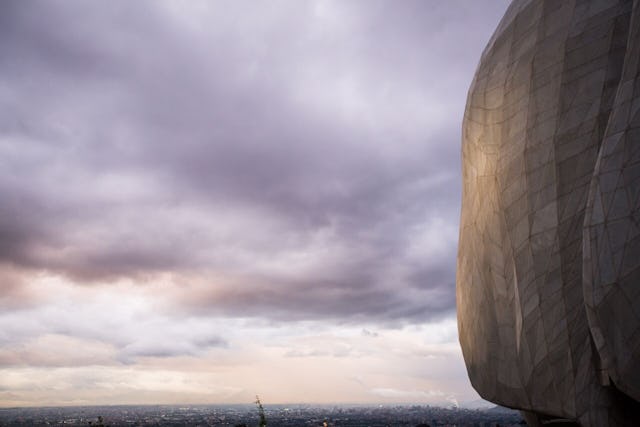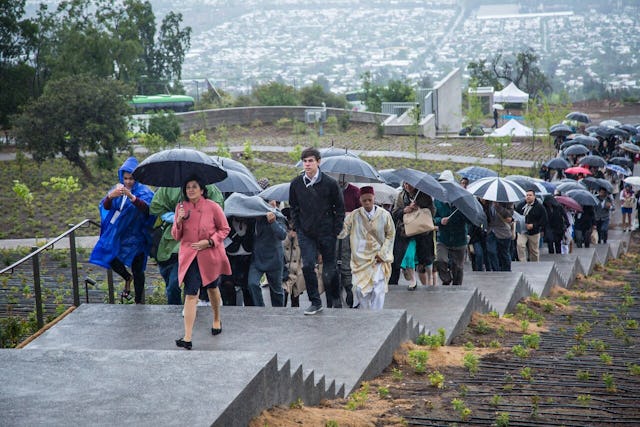Day 2: House of Worship rises from concept to reality
SANTIAGO, Chile — On the second day of the conference marking the opening of the final continental Baha'i House of Worship, participants reflected on the significance of the edifice and its role as a focal point for institutions that will emerge to serve the surrounding population.
Claudio Orrego, the former Mayor of Penalolen and now governor of the Santiago Metropolitan Region, described how the Temple came to be situated at the foothills of the Andes. Expressing his gratitude on behalf of the people of Santiago, he described the Temple's presence there as a "gift of love".
The morning session also paid tribute to the hundreds of people who had contributed to raising the House of Worship.
Juan Carlos Quiroz spoke on behalf of all of the workers on the project. He told the crowd that many of those who had worked on the construction of the Temple were not present, including young volunteers from a variety of countries who, at times, took on the lion's share of the heavy work. He acknowledged the immense, collective endeavor that had given rise to the sacred edifice now being inaugurated.
Among the presentations in the day was a moving historical account of Baha'i Houses of Worship that helped to put into context the occasion being celebrated.
Ximena Osorio, a Colombian Baha'i, spoke of the importance of temples in every religious dispensation and highlighted a unique concept that is associated with Baha'i Houses of Worship:
"In the Baha'i community devotion must find expression in action," she explained. "Prayer, though essential for the inner life of the human being, should lead to actions that give outer expression to inner transformation."
Drawing attention to the very first Baha'i House of Worship—built in Ishqabad (now Ashgabat, Turkmenistan) in 1908—she described how, in its very fiber, the concepts of service and worship were interwoven. That first House of Worship included buildings that served as a travelers' hospice, a school, and medical facility. The education of girls became a priority of the flourishing Baha'i community of the time.
Also addressing the audience, the architect of the Temple, Siamak Hariri, provided a fascinating glimpse into the design process that resulted in the unique structure of the House of Worship in Santiago. His talk honored the many people on the construction team who, in a variety of roles, brought this collaborative effort to such a successful conclusion, and he voiced the architecture team's deep sense of gratitude for the privilege of playing a role in this magnificent project.
"For this, we are immensely thankful," he said.
First visits to the Temple
Throughout the afternoon, groups of around 450 participants traveled in buses for their first visit to the House of Worship and a special devotional program. Often overcome with emotion, joy and gratitude were visible on their beaming faces as they approached the Temple, some through rainfall that added a sense of wonderment to the scene.
Ernestina Cahuaza Chimpuqai, an indigenous Baha'i from Peru, embraced the Faith of Baha'u'llah more than 30 years ago. She flew for the first time in her life to participate in the inauguration of the House of Worship.
"I am very happy and very grateful," she explained, speaking in her native tongue, "because of the blessing that God has given me to visit the Temple."
Celebrating the work of the global Baha'i community
For those remaining at the main conference venue while Temple visits took place, representatives of national Baha’i communities presented how they combine a life of service with worship, as well as insights into their own history and aspects of their culture.
Some of the presentations focused on endeavors of social action and educational initiatives, including examples from various countries in the Americas.
Participants, for instance, highlighted a production of a television series in Ecuador that explores aspects of family life in a neighborhood. The SAT (Sistema Aprendizaje Tutorial) program—which has received government accreditation and recognition by the governments of Colombia and Honduras and provides secondary education to rural youth—was also presented.
Social and economic development initiatives in Chile itself were among the other examples discussed, including one of eight Baha’i-inspired radio stations in South America—named Radio Baha’i—which has worked closely with the indigenous Mapuche people.

